Search Result
Results for "
functional selectivity
" in MedChemExpress (MCE) Product Catalog:
1
Biochemical Assay Reagents
| Cat. No. |
Product Name |
Target |
Research Areas |
Chemical Structure |
-
- HY-148258
-
-
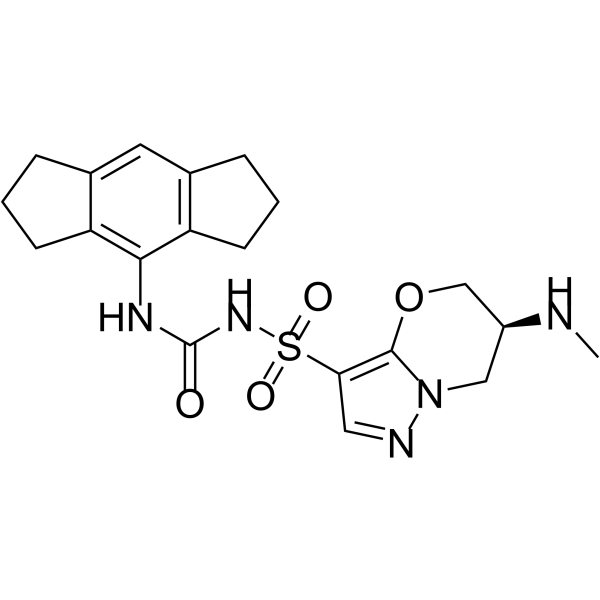
-
- HY-103475
-
|
|
GABA Receptor
|
Neurological Disease
|
|
GS39783 is a positive allosteric modulator (PAM) of GABABR. Positive modulation of the GABABR can be used for the research of Nicotine addiction .
|
-

-
- HY-110132
-
-

-
- HY-161105
-
|
|
5-HT Receptor
|
Others
|
|
FPIP is a selectivity agonist of 5-HT1A with a functional potency (pEC50=8.92) .
|
-
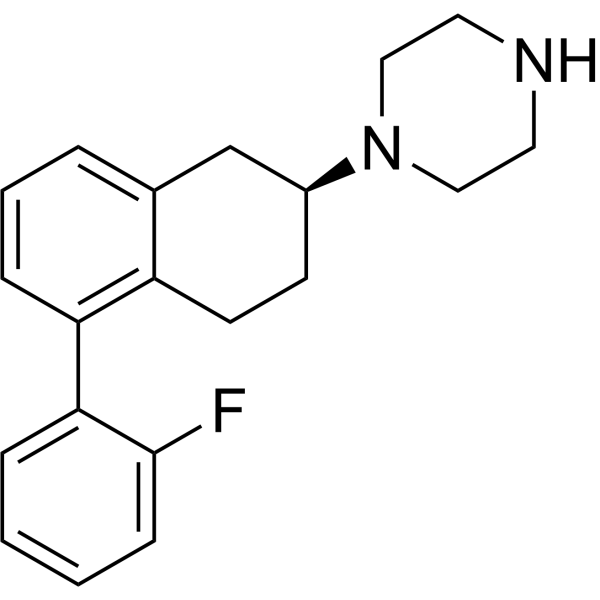
-
- HY-112426
-
-
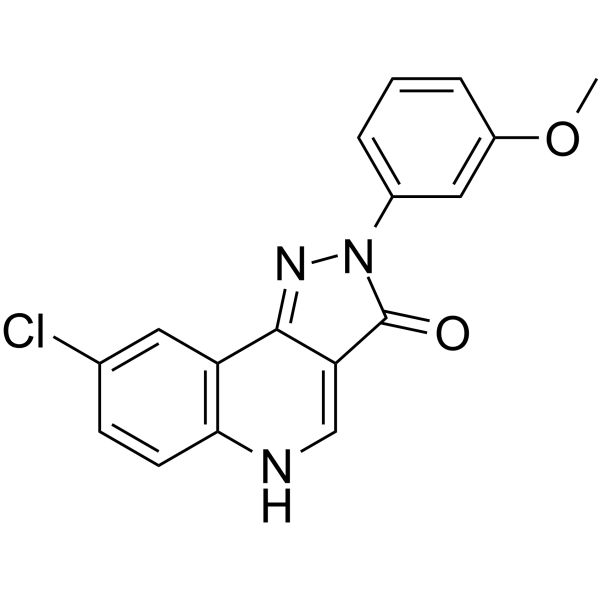
-
- HY-14900
-
|
GRC-10693
|
Cannabinoid Receptor
|
Inflammation/Immunology
|
|
Tedalinab (GRC-10693) is a potent, orally active, and selective cannabinoid receptor 2 (CB2) agonist. Tedalinab has >4700-fold functional selectivity for CB2 over CB1. Tedalinab has potential for neuropathic pain and osteoarthritis treatment .
|
-
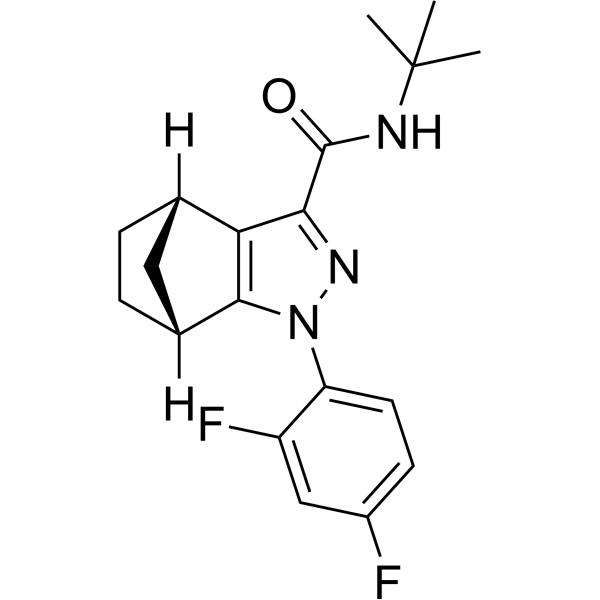
-
- HY-16996A
-
|
|
Sigma Receptor
|
Neurological Disease
|
|
BD-1047 (dihydrobromide) is a selective functional antagonist of sigma-1 receptor, shows antipsychotic activity in animal models predictive of efficacy in schizophrenia .
|
-
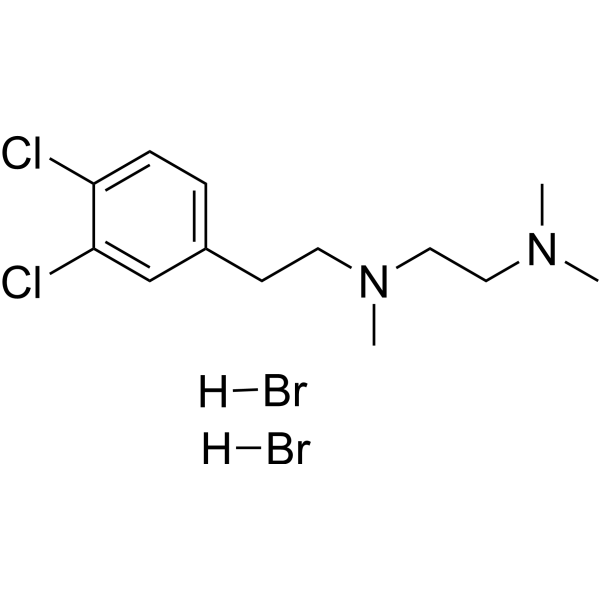
-
- HY-101336
-
|
RS-17053
|
|
|
|
RS 17053 hydrochloride is a potent and selective α1A adrenoceptor antagonist, with a pKi value of 9.1 in native cell membrane and a pA2 value of 9.8 in functional assays.
|
-
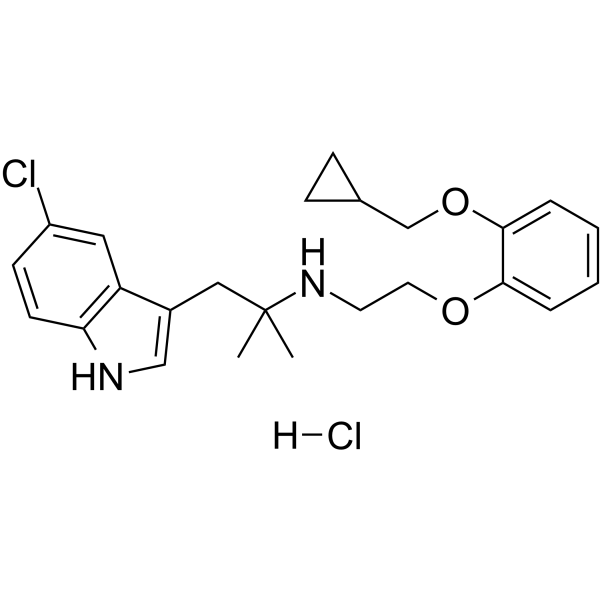
-
- HY-126346
-
|
|
GPR84
|
Inflammation/Immunology
|
|
DL-175 (compound 13) is a selective GPR84 agonist with biased agonistic activity. DL-175 can selectively activate functional responses in immune cells and induce enhanced chemotaxis and phagocytosis of human bone marrow cells. DL-175 is a potential chemical probe .
|
-
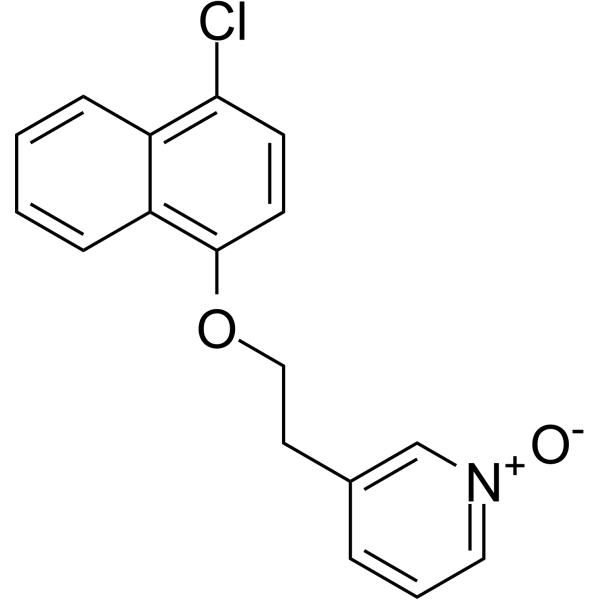
-
- HY-106432A
-
|
SB-202026 hydrochloride; Memric hydrochloride
|
mAChR
|
Neurological Disease
|
|
Sabcomeline (SB-202026) hydrochloride is a potent and functionally selective muscarinic M1 receptor partial agonist that improve cognition. Sabcomeline hydrochloride can be used for Alzheimer's disease research .
|
-
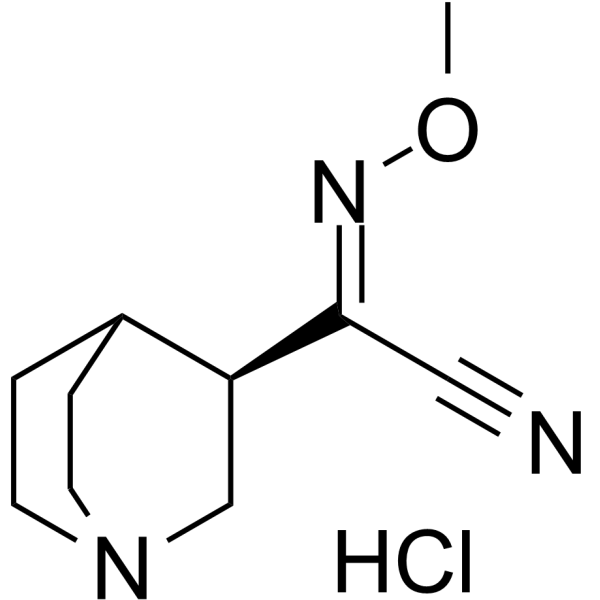
-
- HY-106432
-
|
SB-202026; Memric
|
mAChR
|
Neurological Disease
|
|
Sabcomeline (SB-202026) is a potent and functionally selective muscarinic M1 receptor partial agonist that improve cognition. Sabcomeline can be used for Alzheimer's disease research .
|
-

-
- HY-18760
-
|
|
mGluR
|
Neurological Disease
|
|
LY2812223 is a highly potent, functionally selective mGlu2 receptor agonist with mGlu2 binding affinity for mGlu2 and mGlu3 (Ki=144 nM and 156 nM, respectively) .
|
-
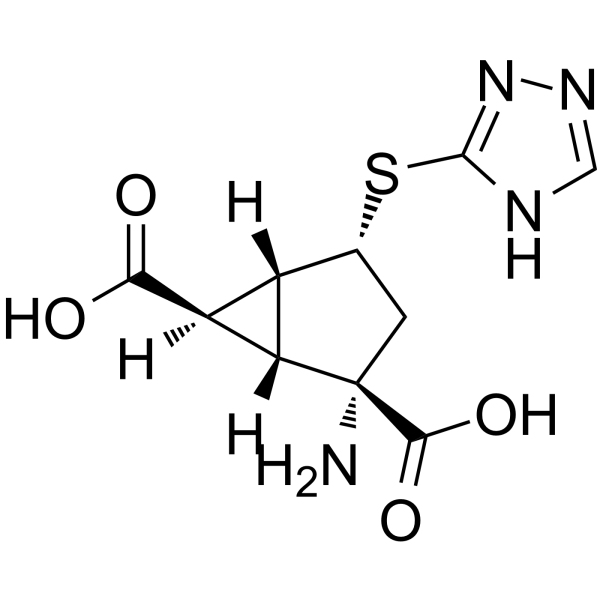
-
- HY-10013
-
|
MK-0364
|
Cannabinoid Receptor
|
Metabolic Disease
|
|
Taranabant is a highly potent and selective cannabinoid 1 (CB1) receptor inverse agonist that inhibits the binding and functional activity of various agonists, with a binding Ki of 0.13 nM for the human CB1R in vitro.
|
-

-
- HY-151682
-
|
|
ADC Linker
|
Others
|
|
H-L-Lys(Norbornene-methoxycarbonyl)-OH, a norbornene-derivatized lysine, can be click-functionalized. H-L-Lys(Norbornene-methoxycarbonyl)-OH can be used for the mild and selective modification of proteins in a copper-free click reaction .
|
-
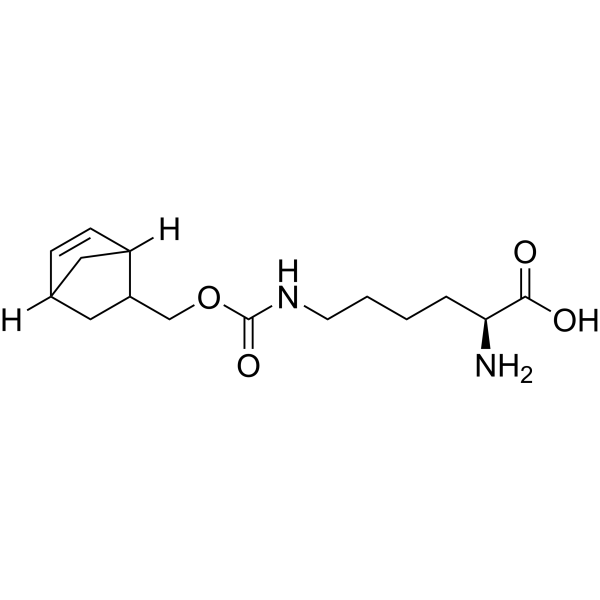
-
- HY-151682A
-
|
|
ADC Linker
|
Others
|
|
H-L-Lys(Norbornene-methoxycarbonyl)-OH hydrochloride, a norbornene-derivatized lysine, can be click-functionalized. H-L-Lys(Norbornene-methoxycarbonyl)-OH hydrochloride can be used for the mild and selective modification of proteins in a copper-free click reaction .
|
-
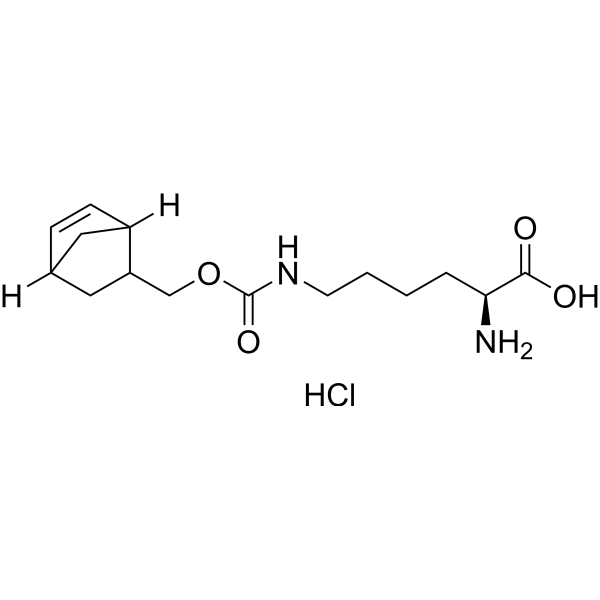
-
- HY-112612
-
|
|
GPR88
|
Neurological Disease
|
|
RTI-13951-33 is a potent, selective, and brain-penetrant GPR88 agonist, with an EC50 of 25 nM in GPR88 cAMP functional assay. RTI-13951-33 reduces alcohol reinforcement and intake behaviors in rats .
|
-
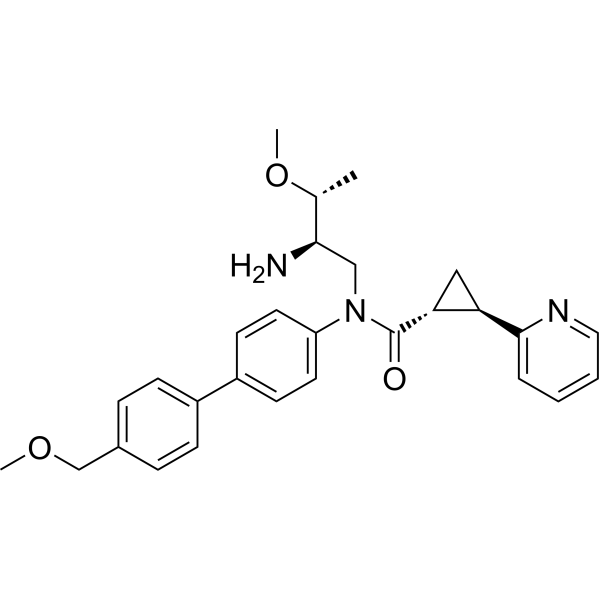
-
- HY-112612A
-
|
|
GPR88
|
Neurological Disease
|
|
RTI-13951-33 hydrochloride is a potent, selective, and brain-penetrant GPR88 agonist, with an EC50 of 25 nM in GPR88 cAMP functional assay. RTI-13951-33 hydrochloride reduces alcohol reinforcement and intake behaviors in rats .
|
-

-
- HY-114231
-
|
ELX-02; NB-124
|
Others
|
Others
|
|
Exaluren (ELX-02) is an synthetic eukaryotic ribosome-selective glycoside that induces read through of nonsense mutations, resulting in normally localized full-length functional proteins. Exaluren is used for the research of cystic fibrosis caused by nonsense mutations .
|
-
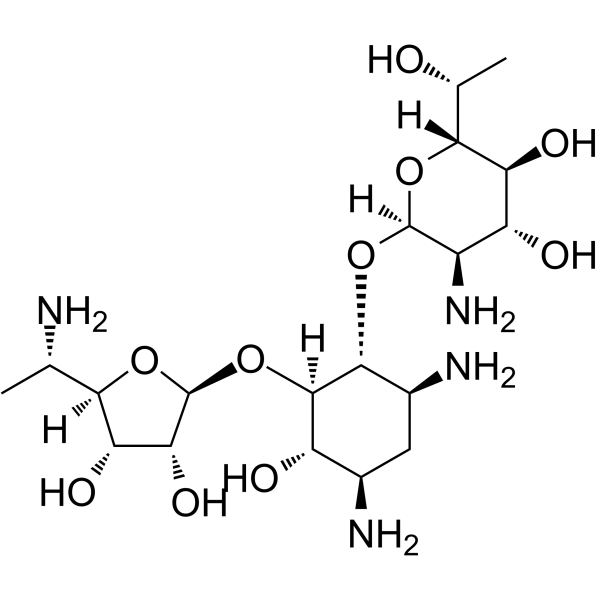
-
- HY-125096
-
|
|
Glucocorticoid Receptor
|
Metabolic Disease
Inflammation/Immunology
|
|
C108297 is a selective glucocorticoid receptor (GR) modulator (GR binding Ki 0.7 nM; GR reporter gene functional Ki 0.6 nM). C108297 attenuates obesity by reducing caloric intake and increasing lipolysis and fat oxidation, and in addition attenuates inflammation .
|
-

-
- HY-114996
-
|
|
ADAMTS
|
Inflammation/Immunology
|
|
ADAMTS-5 Inhibitor is a potent ADAMTS-5 (aggrecanase-2) inhibitor, with an IC50 of 1.1 µM. ADAMTS-5 Inhibitor shows >40-fold functional selectivity over ADAMTS-4 (aggrecanase-1) .
|
-
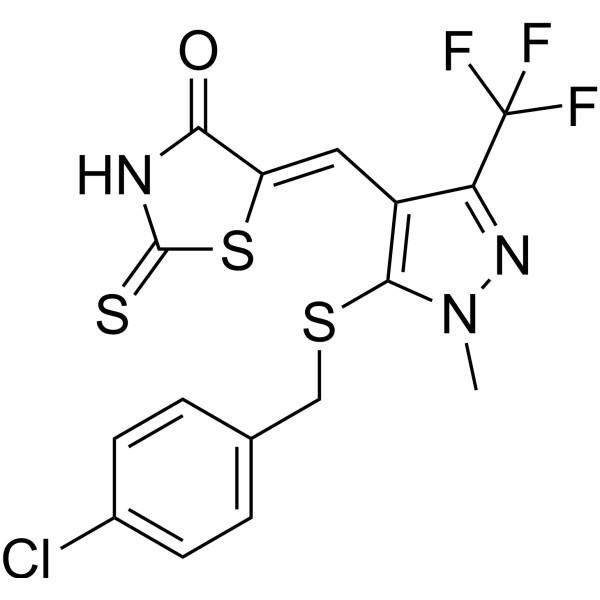
-
- HY-103416
-
|
|
Dopamine Receptor
|
Neurological Disease
|
|
A-77636 hydrochloride is a potent, orally active, selective and long acting dopamine D1 receptor agonist (pKi=7.40; Ki=39.8 nM) with antiparkinsonian activity. A-77636 hydrochloride is functionally inactive at dopamine D2 receptor .
|
-
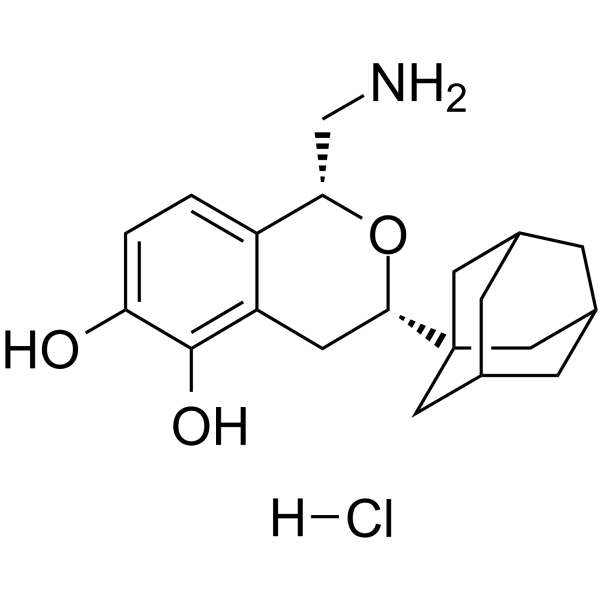
-
- HY-111385
-
|
|
Dopamine Receptor
5-HT Receptor
Arrestin
|
Neurological Disease
|
|
UNC9994 hydrochloride is a functionally selective, β-arrestin–biased dopamine D2 receptor (D2R) agonist that selectively activates β-arrestin recruitment and signaling. UNC9994 hydrochloride shows a binding affinity with a Ki of 79 nM for D2R. UNC9994 hydrochloride is also an antagonist of Gi-regulated cAMP production and partial agonist for D2R/β-arrestin-2 interactions. UNC9994 hydrochloride shows antipsychotic-like activity .
|
-
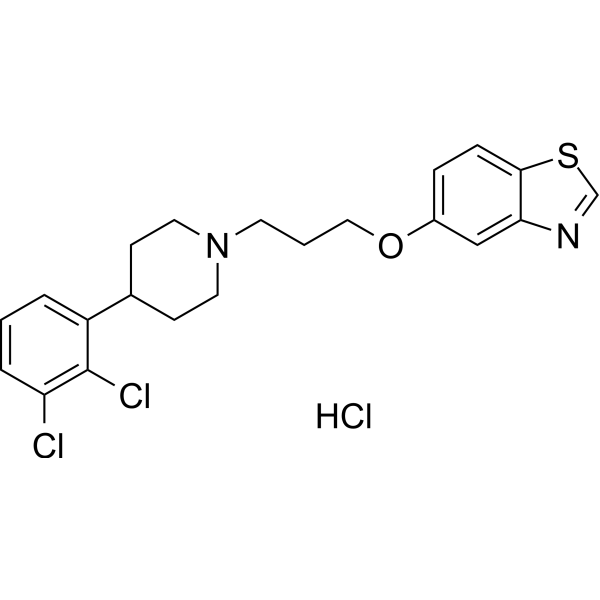
-
- HY-121467A
-
|
Z-338; YM443
|
Cholinesterase (ChE)
|
Others
Metabolic Disease
Inflammation/Immunology
|
|
Acotiamide hydrochloride is an orally active, selective and reversible acetylcholinesterase (AChE) inhibitor, with an IC50 of 1.79 μM. Acotiamide hydrochloride can enhance gastric contractility and accelerate delayed gastric emptying. Acotiamide hydrochloride has the potential for the research of functional dyspepsia involving gastric motility dysfunction and intestinal inflammatory .
|
-
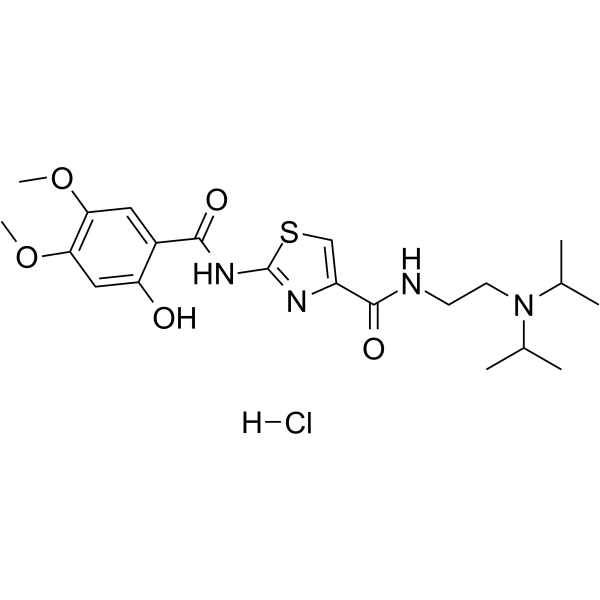
-
- HY-121467
-
|
Z-338 free base; YM443 free base
|
Cholinesterase (ChE)
|
Metabolic Disease
Inflammation/Immunology
|
|
Acotiamide is an orally active, selective and reversible acetylcholinesterase (AChE) inhibitor, with an IC50 of 1.79 μM. Acotiamide can enhance gastric contractility and accelerate delayed gastric emptying. Acotiamide has the potential for the research of functional dyspepsia involving gastric motility dysfunction and intestinal inflammatory .
|
-
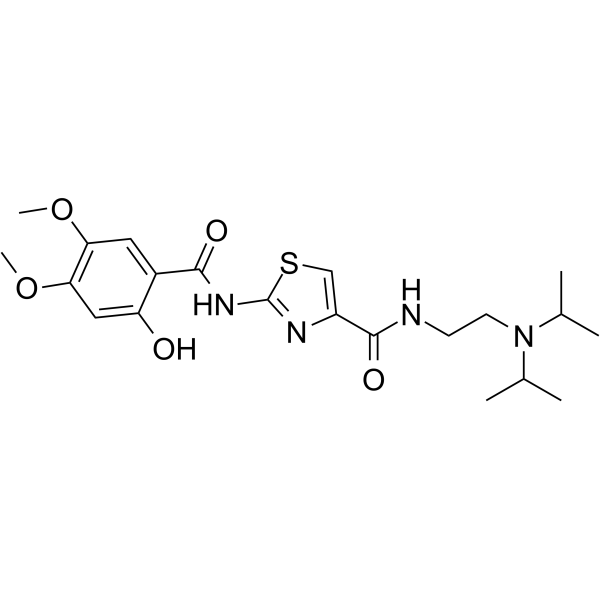
-
- HY-19618
-
|
|
|
|
|
BRD3308 is a highly selective HDAC3 inhibitor with an IC50 of 54 nM. BRD3308 is 23-fold selectivity for HDAC3 over HDAC1 (IC50 of 1.26 μM) or HDAC2 (IC50 of 1.34 μM). BRD3308 suppresses pancreatic β-cell apoptosis induced by inflammatory cytokines or glucolipotoxic stress, and increases functional insulin release. BRD3308 activates HIV-1 transcription and disrupts HIV-1 latency .
|
-
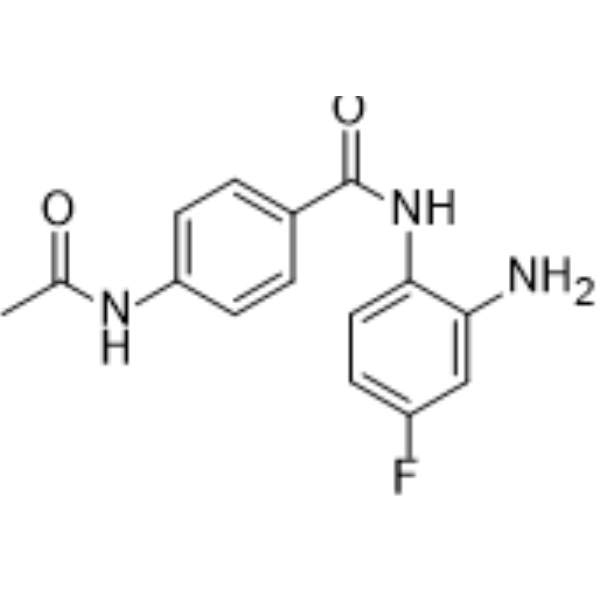
-
- HY-D0976
-
|
|
P2X Receptor
HIV
|
Infection
|
|
NF279 is a potent selective and reversible P2X1 receptor antagonist, with an IC50 of 19 nM. NF279 displays good selectivity over P2X2, P2X3 (IC50=1.62 μM), P2X4 (IC50>300 μM). NF279 is a dual HIV-1 coreceptor inhibitor that interferes with the functional engagement of CCR5 and CXCR4 by Env .
|
-
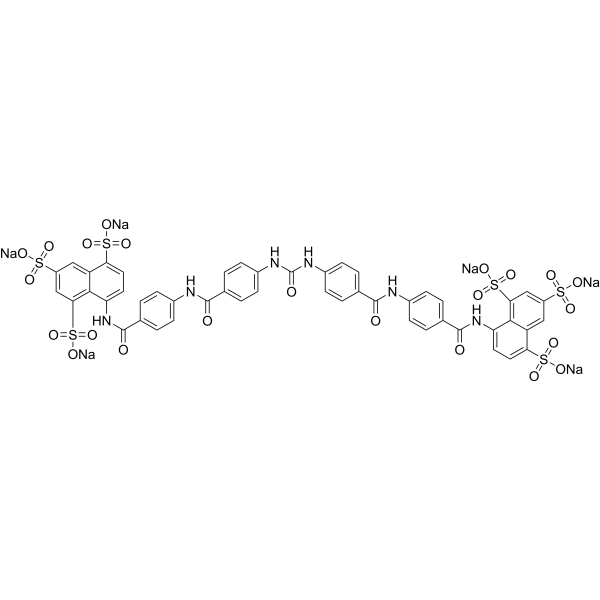
-
- HY-115487
-
|
|
Prostaglandin Receptor
|
Inflammation/Immunology
Cancer
|
|
MF-766 is a highly potent, selective and orally active EP4 antagonist with a Ki of 0.23 nM. MF-766 behaves as a full antagonist with an IC50 of 1.4 nM (shifted to 1.8 nM in the presence of 10% HS) in the functional assay. MF-766 can be used for cancer and inflammation diseases research .
|
-
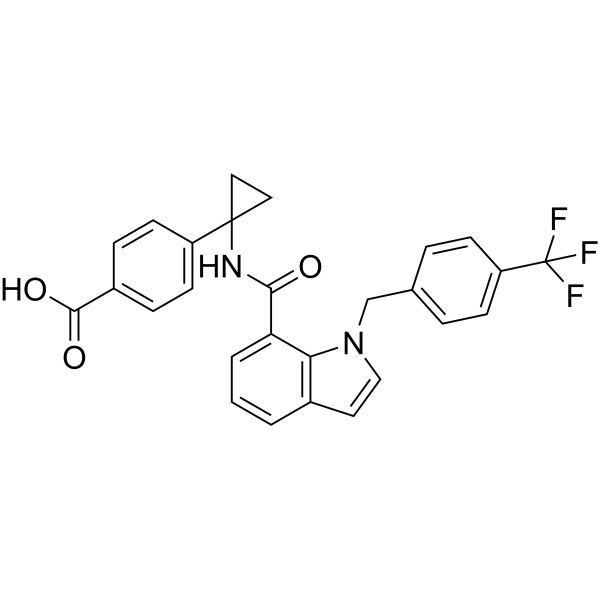
-
- HY-18664
-
PFI-4
1 Publications Verification
|
Epigenetic Reader Domain
|
Cancer
|
|
PFI-4 (compound 11) is a potent and highly selective BRPF1 Bromodomain (BRPF1B) inhibitor, with an IC50 of 172 nM. PFI-4 can be used to explore the functional mechanisms of the HBO1/BRPF1 complex and to study bone loss and osteolytic malignant bone lesions .
|
-
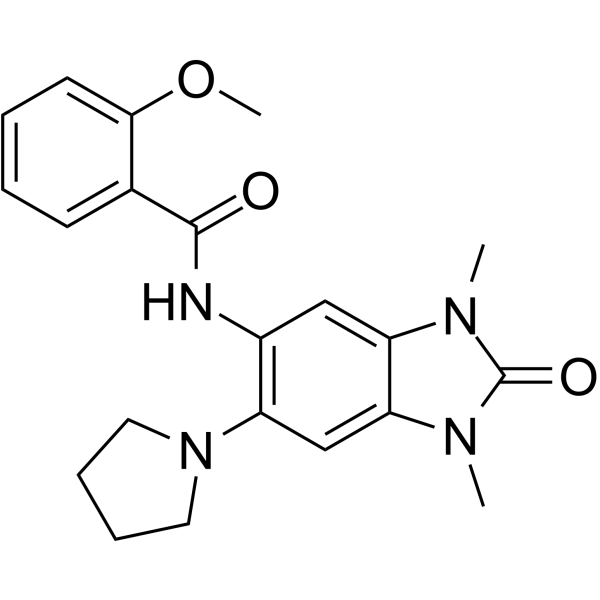
-
- HY-B2155
-
|
|
|
|
|
Acotiamide monohydrochloride trihydrate is an orally active, selective and reversible acetylcholinesterase (AChE) inhibitor, with IC50 of 1.79 μM. Acotiamide monohydrochloride trihydrate can enhance gastric contractility and accelerate delayed gastric emptying. Acotiamide monohydrochloride trihydrate has the potential for the research of functional dyspepsia involving gastric motility dysfunction and intestinal inflammatory .
|
-

-
- HY-126220
-
|
|
Fluorescent Dye
|
Others
|
|
KMG-301AM is the acetoxy methyl esterified form of KMG-301. KMG-301AM successfully accumulates in mitochondria and then it is hydrolyzed to KMG-301. KMG-301 is an Mg 2+-selective fluorescent probe functional in mitochondria in intact cells. Since the mitochondrial membrane is impermeable to KMG-301, it is not released upon depolarization of the mitochondrial membrane potential. KMG-301 can indicate changes in mitochondrial Mg2+ concentration and shows Mg 2+ transport across the mitochondrial membrane in the early phases of a cellular model .
|
-
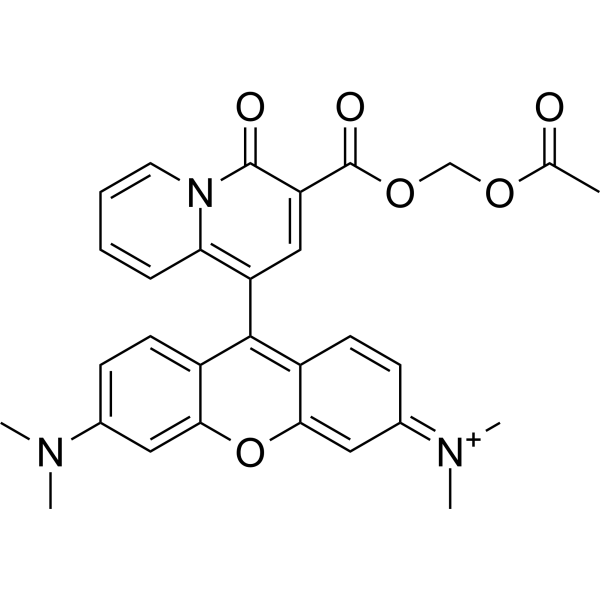
-
- HY-14495
-
|
EX-1314
|
GHSR
|
Metabolic Disease
|
|
BMS-604992 (EX-1314) is a selective, orally active small-molecule growth hormone secretagogue receptor (GHSR) agonist. BMS-604992 demonstrates high-affinity binding (Ki=2.3 nM) and potent functional activity (EC50=0.4 nM). BMS-604992 can stimulate food intake in rodents .
|
-
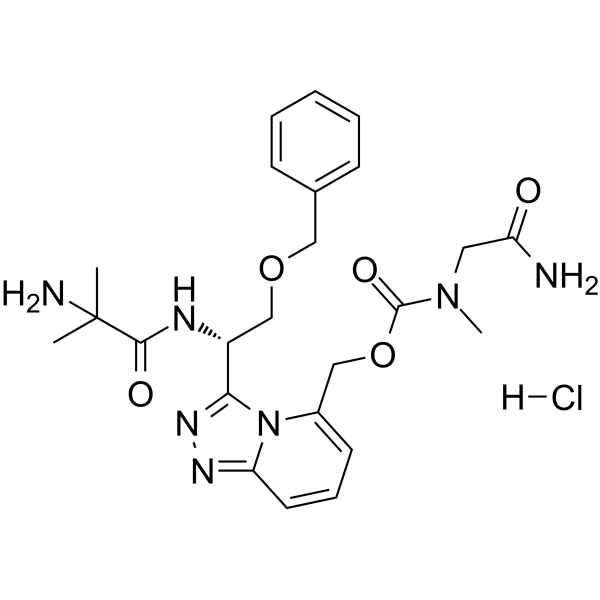
-
- HY-14495B
-
|
EX-1314 dihydrochloride
|
GHSR
|
Metabolic Disease
|
|
BMS-604992 (EX-1314) dihydrochloride is a selective, orally active small-molecule growth hormone secretagogue receptor (GHSR) agonist. BMS-604992 dihydrochloride demonstrates high-affinity binding (ki=2.3 nM) and potent functional activity (EC50=0.4 nM). BMS-604992 dihydrochloride can stimulate food intake in rodents .
|
-

-
- HY-13499
-
|
CCR2 antagonist 5
|
CCR
|
Inflammation/Immunology
|
|
JNJ-41443532 (CCR2 antagonist 5) is a selective, orally active hCCR2 inhibitor with good binding affinity (IC50=37 nM) and potent functional antagonism (chemotaxis IC50=30 nM). JNJ-41443532 displays a Ki of 9.6 µM for mCCR2 binding. JNJ-41443532 can be used in the research of inflammatory disease .
|
-
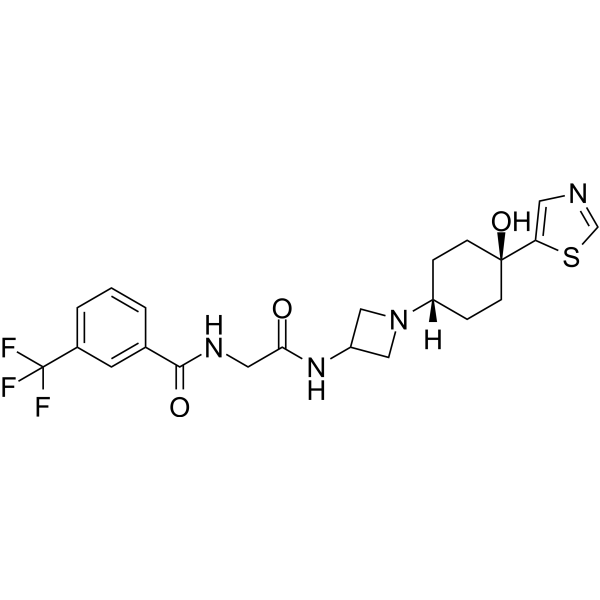
-
- HY-126220A
-
|
|
Fluorescent Dye
|
Others
|
|
KMG-301AM TFA is the acetoxy methyl esterified form of KMG-301. KMG-301AM TFA successfully accumulates in mitochondria and then it is hydrolyzed to KMG-301. KMG-301 is an Mg 2+-selective fluorescent probe functional in mitochondria in intact cells. Since the mitochondrial membrane is impermeable to KMG-301, it is not released upon depolarization of the mitochondrial membrane potential. KMG-301 can indicate changes in mitochondrial Mg2+ concentration and shows Mg 2+ transport across the mitochondrial membrane in the early phases of a cellular model .
|
-
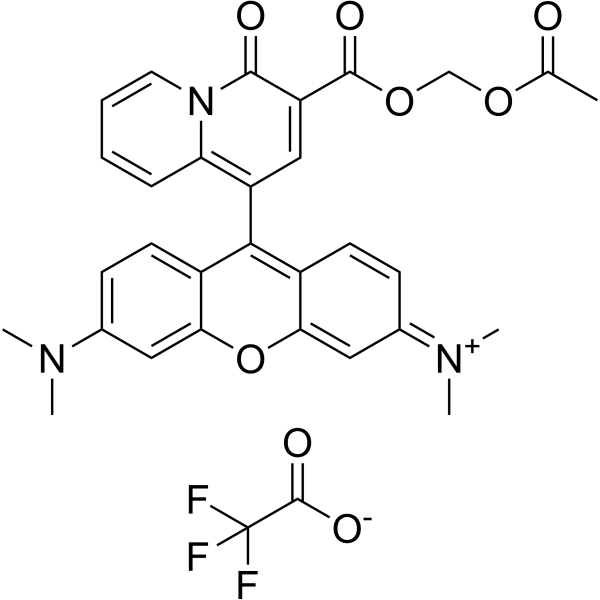
-
- HY-14348
-
|
|
5-HT Receptor
Dopamine Receptor
|
Neurological Disease
|
|
GSK163090 is a potent, selective and orally active 5-HT1A/1B/1D receptor antagonist with pKi values of 9.4/8.5/9.7, respectively. GSK163090 inhibits the functional activity of serotonin reuptake transporter (SerT) with a pKi value of 6.1. GSK163090 has antidepressant and anxiolytic activities .
|
-

-
- HY-117829
-
|
|
Dopamine Receptor
5-HT Receptor
Histamine Receptor
Arrestin
|
Neurological Disease
|
|
UNC9994, an analog of Aripiprazole, is a functionally selective β-arrestin-biased dopamine D2 receptor (D2R) agonist with EC50 <10 nM for β-arrestin-2 recruitment to D2 receptors. UNC9994 is simultaneously partial agonists of β-arrestin-2 translocation and antagonists of Gi-regulated cAMP production. Antipsychotic Activity .
|
-
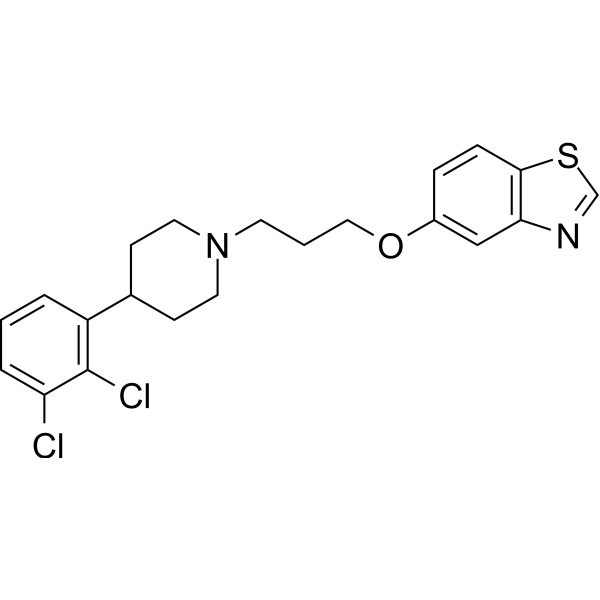
-
- HY-14495A
-
|
EX-1314 free base
|
GHSR
|
Metabolic Disease
|
|
BMS-604992 (EX-1314) free base is a selective, orally active small-molecule growth hormone secretagogue receptor (GHSR) agonist. BMS-604992 free base demonstrates high-affinity binding (ki=2.3 nM) and potent functional activity (EC50=0.4 nM). BMS-604992 free base can stimulate food intake in rodents .
|
-
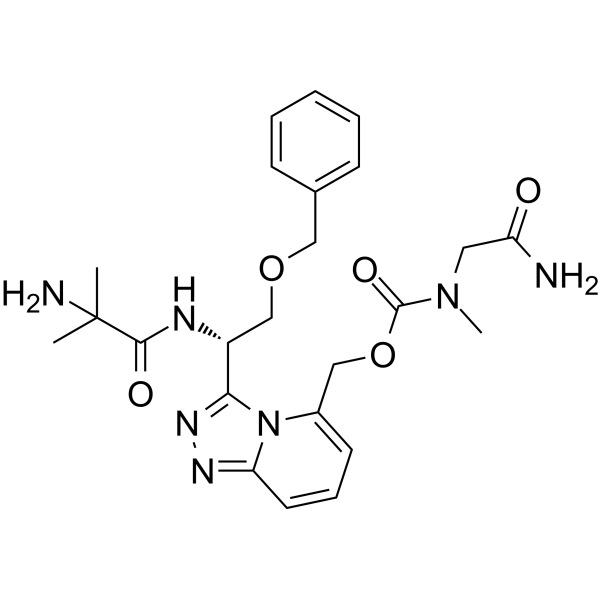
-
- HY-112626
-
|
|
CDK
|
Cancer
|
|
CDK12-IN-2 is a potent, selective and nanomolar CDK12 inhibitor (IC50=52 nM) with good physicochemical properties. CDK12-IN-2 is also a strong CDK13 inhibitor due to CDK13 is the closest homologue of CDK12. CDK12-IN-2 shows excellent kinase selectivity for CDK12 over CDK2, 9, 8, and 7. CDK12-IN-2 inhibits the phosphorylation of Ser2 in the C-terminal domain of RNA polymerase II. CDK12-IN-2 can be used an excellent chemical probe for functional studies of CDK12 .
|
-

-
- HY-101189
-
|
|
Histamine Receptor
|
Neurological Disease
Endocrinology
|
|
JNJ-39758979 is a selective, orally active, and high-affinity histamine H4 receptor antagonist with Kis of 12.5, 5.3, and 25 nM for human, mouse, and monkey histamine H4 receptor, respectively. JNJ-39758979 functionally antagonizes histamine-induced cAMP inhibition with a pA2 of 7.9 in transfected cells. JNJ-39758979 shows good anti-inflammatory and antipruritic activity .
|
-

-
- HY-113618A
-
|
|
CRAC Channel
Interleukin Related
|
Cardiovascular Disease
|
|
RO2959 hydrochloride is a potent and selective CRAC channel inhibitor with an IC50 of 402 nM. RO2959 hydrochloride is a potent blocker of store operated calcium entry (SOCE) mediated by Orai1/Stim1 channels with an IC50 of 25 nM. RO2959 hydrochloride is also a potent inhibitor of human IL-2 production, and potently blocks T cell receptor triggered gene expression and T cell functional pathways .
|
-
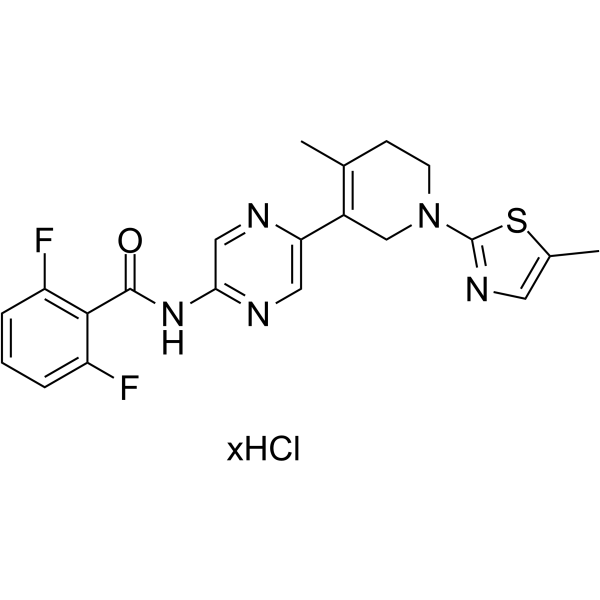
-
- HY-101189B
-
|
|
Histamine Receptor
|
Inflammation/Immunology
|
|
JNJ-39758979 dihydrochloride is a selective, orally active, and high-affinity histamine H4 receptor antagonist, with Kis of 12.5, 5.3, and 25 nM for human, mouse, and monkey histamine H4 receptor, respectively. JNJ-39758979 dihydrochloride functionally antagonizes histamine-induced cAMP inhibition with a pA2 of 7.9 in transfected cells. JNJ-39758979 dihydrochloride shows good anti-inflammatory and antipruritic activity .
|
-
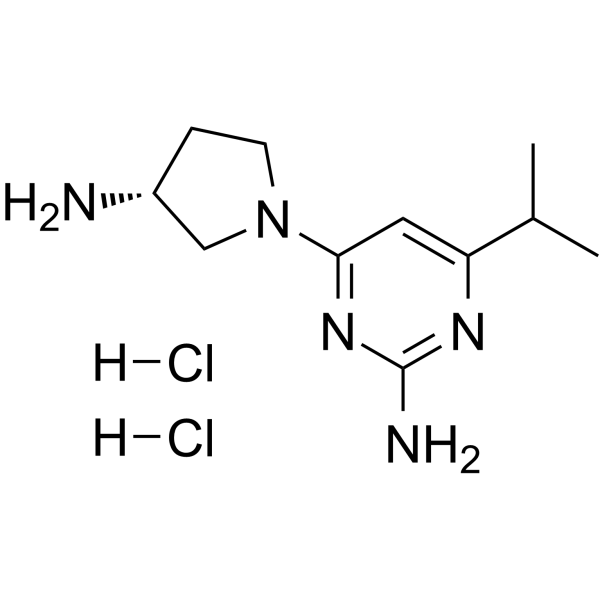
-
- HY-Y0415
-
|
N,N,N-triethylethanaminium (fluoride)
|
|
|
|
Tetraethylammonium fluoride is an organic compound containing both ammonium and fluorine functional groups. It is commonly used as a reagent in various chemical synthesis applications, especially as a source of fluoride ions for nucleophilic reactions. Tetraethylammonium fluoride has several properties that make it suitable for these applications, including its high solubility in polar solvents and its ability to selectively activate certain chemical bonds. In addition, it is used as a catalyst for organic reactions and as a surfactant in the production of semiconductors and microelectronics.
|
-

-
- HY-Y0971
-
|
TBAF
|
Biochemical Assay Reagents
|
Others
|
|
Tetrabutylammonium fluoride is an organic compound containing both ammonium and fluorine functional groups. It is commonly used as a reagent in various chemical synthesis applications, especially as a source of fluoride ions for nucleophilic reactions. Tetrabutylammonium fluoride has several properties that make it suitable for these applications, including its high solubility in polar solvents and its ability to selectively activate certain chemical bonds. In addition, it can be used as a catalyst for organic reactions and as an electrolyte for batteries.
|
-
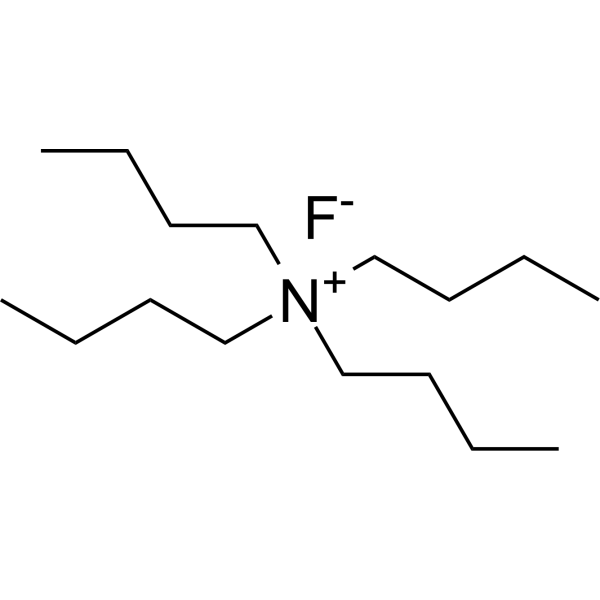
-
- HY-107678
-
|
WAY-317538
|
nAChR
|
Neurological Disease
|
|
SEN 12333 (WAY-317538) is a potent, selective and orally active α7 nAChR agonist. SEN12333 displays high affinity for the rat α7 nAChRs expressed in GH4C1 cells (K>i=260 nM) and acts as full agonist in functional Ca 2+ flux studies (EC50=1.6 μM). SEN 12333 is used for AD and schizophrenia research .
|
-

-
- HY-103441
-
|
|
EGFR
|
Cancer
|
|
JNJ28871063 hydrochloride is an orally active, highly selective and ATP competitive pan-ErbB kinase inhibitor with IC50 values of 22 nM, 38 nM, and 21 nM for ErbB1, ErbB2, and ErbB4, respectively. JNJ28871063 hydrochloride inhibits phosphorylation of functionally important tyrosine residues in both EGFR and ErbB2. JNJ28871063 hydrochloride crosses the blood-brain barrier and has antitumor activity in human tumor xenograft models that overexpress EGFR and ErbB2 .
|
-
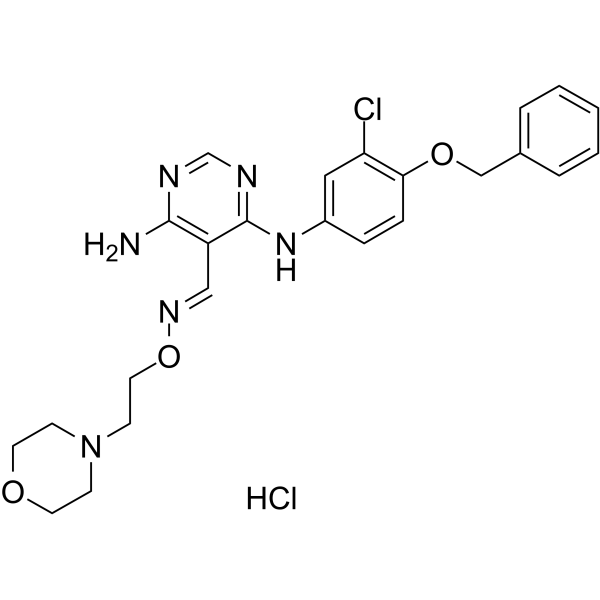
-
- HY-113618B
-
|
|
CRAC Channel
Interleukin Related
|
Cardiovascular Disease
|
|
RO2959 monohydrochloride is a potent and selective CRAC channel inhibitor with an IC50 of 402 nM. RO2959 monohydrochloride is a potent blocker of store operated calcium entry (SOCE) mediated by Orai1/Stim1 channels with an IC50 of 25 nM. RO2959 monohydrochloride is also a potent inhibitor of human IL-2 production, and potently blocks T cell receptor triggered gene expression and T cell functional pathways .
|
-
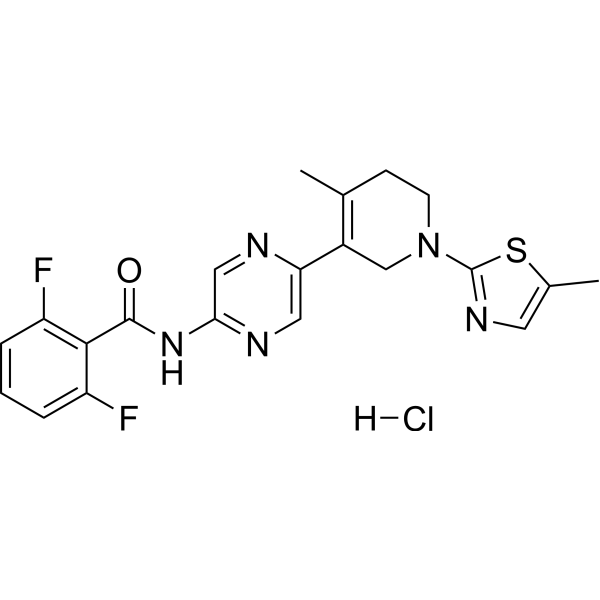
-
- HY-123857
-
|
|
P2X Receptor
|
Neurological Disease
Inflammation/Immunology
|
|
JNJ-55308942 is a high-affinity, selective, brain-penetrant P2X7 functional antagonist (hP2X7: IC50=10 nM, Ki=7.1 nM; rP2X7: IC50=15 nM, Ki=2.9 nM). JNJ-55308942 is orally bioavailable, binds to brain P2X7 and blocks IL-1β release from adult rodent brain .
|
-

-
- HY-115531
-
|
|
Others
|
Cancer
|
|
UNC-2170 is a functionally active, fragment-like ligand for 53BP1 (IC50=29 µM; Kd=22 µM). UNC-2170 shows at least 17-fold selectivity for 53BP1 as compared to nine other methyl-lysine (Kme) reader proteins. 53BP1 is a Kme binding protein that plays a central role in DNA Damage Repair (DDR) pathways and is recruited to sites of double-strand breaks (DSB) .
|
-
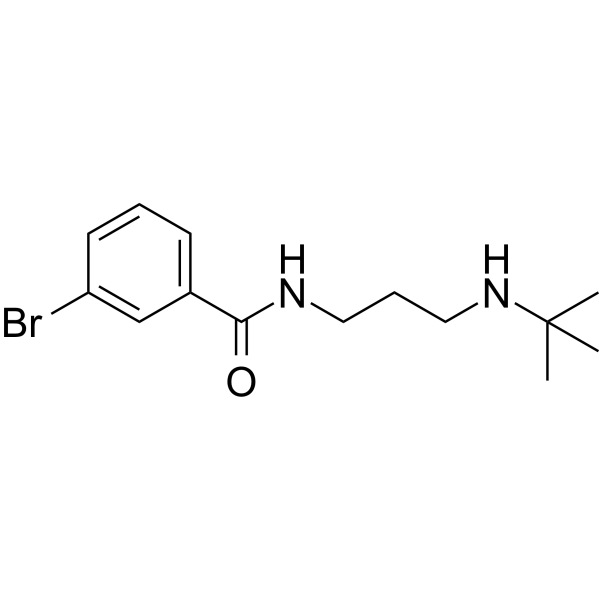
-
- HY-P0172A
-
|
|
CXCR
|
Inflammation/Immunology
Endocrinology
Cancer
|
|
ATI-2341 is a potent and functionally selective allosteric agonist of C-X-C chemokine receptor type 4 (CXCR4), which functions as a biased ligand, favoring Gαi activation over Gα13. ATI-2341 activates the inhibitory heterotrimeric G protein (Gi) to promote inhibition of cAMP production and induce calcium mobilization. ATI-2341 is a potent and efficacious mobilizer of bone marrow polymorphonuclear neutrophils (PMNs) and hematopoietic stem and progenitor cells (HSPCs) .
|
-
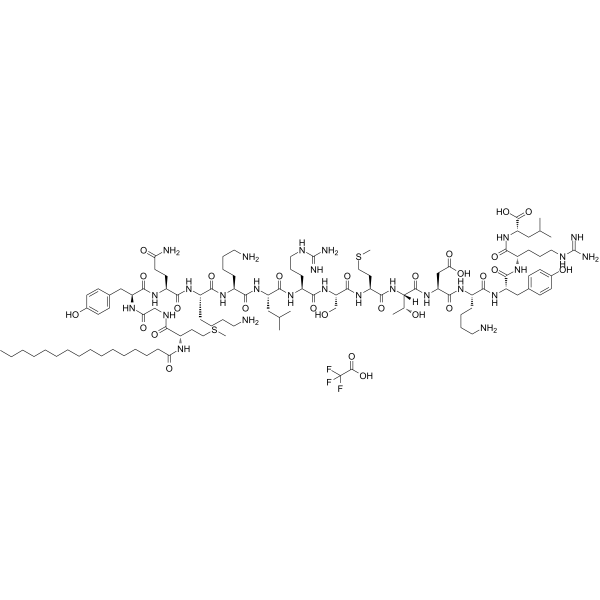
-
- HY-P0172
-
|
|
CXCR
|
Inflammation/Immunology
Endocrinology
Cancer
|
|
ATI-2341 is a potent and functionally selective allosteric agonist of C-X-C chemokine receptor type 4 (CXCR4), which functions as a biased ligand, favoring Gαi activation over Gα13. ATI-2341 activates the inhibitory heterotrimeric G protein (Gi) to promote inhibition of cAMP production and induce calcium mobilization. ATI-2341 is a potent and efficacious mobilizer of bone marrow polymorphonuclear neutrophils (PMNs) and hematopoietic stem and progenitor cells (HSPCs) .
|
-
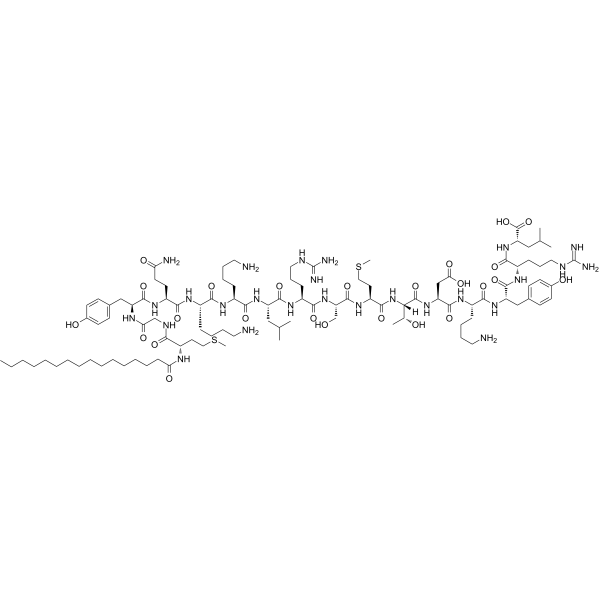
- HY-P4685
-
|
|
Angiotensin Receptor
|
Metabolic Disease
|
|
(Sar1,Ile4,8)-Angiotensin II is a functionally selective angiotensin II type 1 receptor (AT1R) agonist. (Sar1,Ile4,8)-Angiotensin II potentiates insulin-stimulated insulin receptor (IR) signaling and glycogen synthesis. (Sar1,Ile4,8)-Angiotensin II potentiates insulin-stimulated phosphorylation of Akt and GSK3α/β .
|
-

- HY-19978
-
|
|
|
|
|
RO-3 is a potent, CNS-penetrant, and orally active P2X3 and P2X2/3 antagonist with pIC50s of 5.9 and 7.0 for human homomultimeric P2X3 and heteromultimeric P2X2/3 receptors, respectively. RO-3 shows selectivity for P2X3 and P2X2/3 over all other functional homomultimeric P2X receptors (IC50 >10 μM at P2X1,2,4,5,7) .
|
-
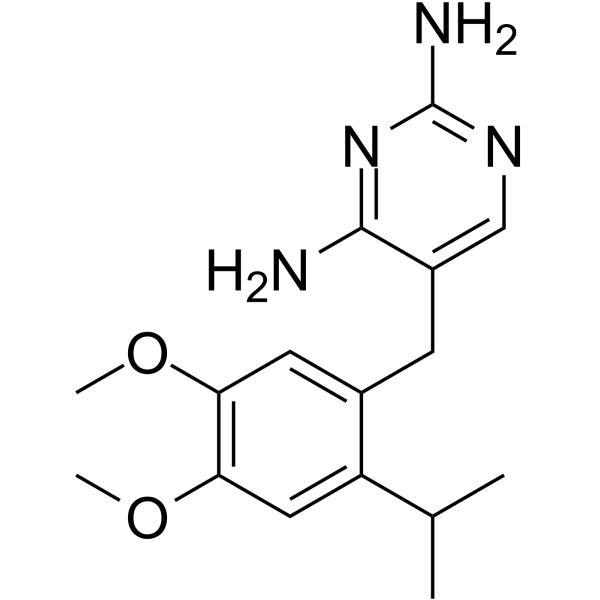
| Cat. No. |
Product Name |
Type |
-
- HY-Y0971
-
|
TBAF
|
Biochemical Assay Reagents
|
|
Tetrabutylammonium fluoride is an organic compound containing both ammonium and fluorine functional groups. It is commonly used as a reagent in various chemical synthesis applications, especially as a source of fluoride ions for nucleophilic reactions. Tetrabutylammonium fluoride has several properties that make it suitable for these applications, including its high solubility in polar solvents and its ability to selectively activate certain chemical bonds. In addition, it can be used as a catalyst for organic reactions and as an electrolyte for batteries.
|
| Cat. No. |
Product Name |
Target |
Research Area |
-
- HY-P0172A
-
|
|
CXCR
|
Inflammation/Immunology
Endocrinology
Cancer
|
|
ATI-2341 is a potent and functionally selective allosteric agonist of C-X-C chemokine receptor type 4 (CXCR4), which functions as a biased ligand, favoring Gαi activation over Gα13. ATI-2341 activates the inhibitory heterotrimeric G protein (Gi) to promote inhibition of cAMP production and induce calcium mobilization. ATI-2341 is a potent and efficacious mobilizer of bone marrow polymorphonuclear neutrophils (PMNs) and hematopoietic stem and progenitor cells (HSPCs) .
|
-
- HY-P4685
-
|
|
Angiotensin Receptor
|
Metabolic Disease
|
|
(Sar1,Ile4,8)-Angiotensin II is a functionally selective angiotensin II type 1 receptor (AT1R) agonist. (Sar1,Ile4,8)-Angiotensin II potentiates insulin-stimulated insulin receptor (IR) signaling and glycogen synthesis. (Sar1,Ile4,8)-Angiotensin II potentiates insulin-stimulated phosphorylation of Akt and GSK3α/β .
|
-
- HY-P0172
-
|
|
CXCR
|
Inflammation/Immunology
Endocrinology
Cancer
|
|
ATI-2341 is a potent and functionally selective allosteric agonist of C-X-C chemokine receptor type 4 (CXCR4), which functions as a biased ligand, favoring Gαi activation over Gα13. ATI-2341 activates the inhibitory heterotrimeric G protein (Gi) to promote inhibition of cAMP production and induce calcium mobilization. ATI-2341 is a potent and efficacious mobilizer of bone marrow polymorphonuclear neutrophils (PMNs) and hematopoietic stem and progenitor cells (HSPCs) .
|
| Cat. No. |
Product Name |
|
Classification |
-
- HY-151682
-
|
|
|
TCO
Labeling and Fluorescence Imaging
|
|
H-L-Lys(Norbornene-methoxycarbonyl)-OH, a norbornene-derivatized lysine, can be click-functionalized. H-L-Lys(Norbornene-methoxycarbonyl)-OH can be used for the mild and selective modification of proteins in a copper-free click reaction .
|
-
- HY-151682A
-
|
|
|
Labeling and Fluorescence Imaging
TCO
|
|
H-L-Lys(Norbornene-methoxycarbonyl)-OH hydrochloride, a norbornene-derivatized lysine, can be click-functionalized. H-L-Lys(Norbornene-methoxycarbonyl)-OH hydrochloride can be used for the mild and selective modification of proteins in a copper-free click reaction .
|
-
- HY-115715A
-
|
|
|
Alkynes
|
|
EN219-alkyne is an alkyne-functionalized EN219 probe. EN219 (HY-P0287A) is a moderately selective synthetic covalent ligand against an N-terminal cysteine (C8) of RNF114 with an IC50 of 470 nM. EN219 inhibits RNF114-mediated autoubiquitination and p21 ubiquitination . EN219-alkyne is a click chemistry reagent, it contains an Alkyne group and can undergo copper-catalyzed azide-alkyne cycloaddition (CuAAc) with molecules containing Azide groups.
|
Your information is safe with us. * Required Fields.
Inquiry Information
- Product Name:
- Cat. No.:
- Quantity:
- MCE Japan Authorized Agent:




























































